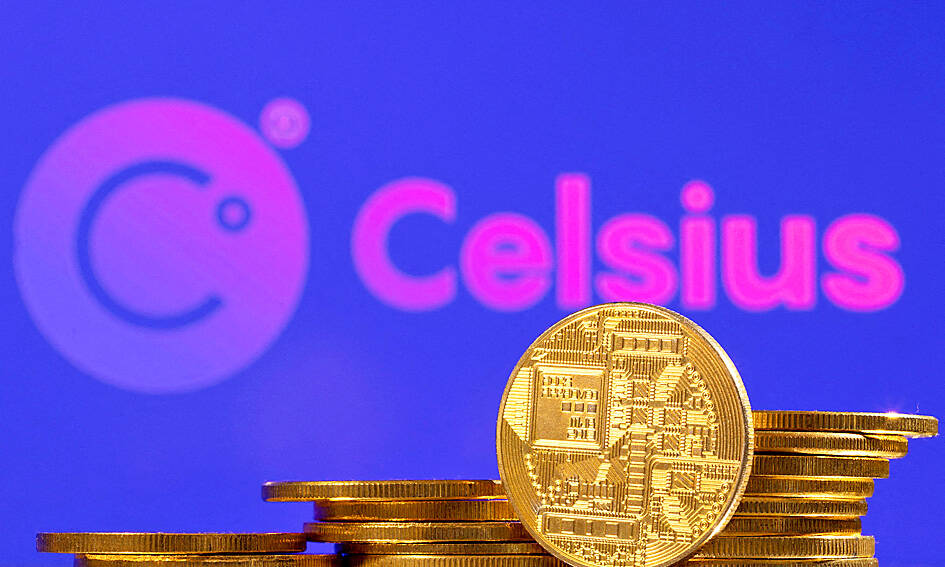US regulators are prying deep into the remnants of failed hedge fund Three Arrows Capital Pte Ltd (3AC, 三箭資本) as they try to untangle the fallout of this year’s crypto crash.
Three Arrows, which until recently was one of the industry’s most prominent firms, filed for bankruptcy in July after the broad sell-off in digital assets spurred in part by the collapse of the terra blockchain.
The US Commodity Futures Trading Commission (CFTC) and the US Securities and Exchange Commission (SEC) are looking into whether the money manager breached rules by misleading investors about the strength of its balance sheet and not registering with the agencies, two people familiar with the matter said.

Photo: Reuters
Scrutiny from the agencies, both of which declined to comment, can lead to monetary fines and other penalties for firms and individuals.
At its zenith, Three Arrows counted a few billion dollars under management, making it a major player in the crypto world. Known for its bullish stance, it was also a recipient of loans from firms across the industry, and was a venture investor in some of the industry’s best-known start-ups.
However, the firm sustained losses on its position in the terra blockchain project, which came crashing down as the so-called algorithmic stablecoin terraUSD crumbled in May.
As the token’s collapse spread across the broader crypto market over the following weeks, Three Arrows was unable to meet margin calls from its lenders and eventually declared insolvency.
Liquidators overseeing the wind-down of the firm, which operated from Singapore until at least early May, have seized control of tens of millions of dollars of the fund’s assets.
However, that is a fraction of the billions of dollars that creditors, including bankrupt crypto lenders Voyager Digital and Celsius Network, said they were owed.
Teneo, the court appointed liquidator, has claimed that Three Arrows’ founders have not fully cooperated with the unwinding.
They took the unusual step of asking a US judge for permission to serve founders Zhu Su (蘇朱) and Kyle Davies with subpoenas through their Twitter accounts and e-mail addresses, because normal methods have failed, court documents filed last week showed.
Celsius Network LLC is also facing scrutiny from US regulators. Lawyers for the firm this month disclosed that it had received a federal grand jury subpoena from the US District Court for the Southern District of New York, as well as inquiries from the CFTC, the SEC and the US Federal Trade Commission.
The CFTC is investigating if Celsius failed to disclose how customers’ funds were used and if some of its conduct amounted to market manipulation, a person familiar with the matter said.
Although the CFTC’s jurisdiction over crypto is generally limited to derivatives, the agency can take enforcement action if it believes there is fraud or manipulation in the underlying market. The SEC claims oversight over digital coins that qualify as securities under its rules. Both regulators also oversee investment firms.

With this year’s Semicon Taiwan trade show set to kick off on Wednesday, market attention has turned to the mass production of advanced packaging technologies and capacity expansion in Taiwan and the US. With traditional scaling reaching physical limits, heterogeneous integration and packaging technologies have emerged as key solutions. Surging demand for artificial intelligence (AI), high-performance computing (HPC) and high-bandwidth memory (HBM) chips has put technologies such as chip-on-wafer-on-substrate (CoWoS), integrated fan-out (InFO), system on integrated chips (SoIC), 3D IC and fan-out panel-level packaging (FOPLP) at the center of semiconductor innovation, making them a major focus at this year’s trade show, according

DEBUT: The trade show is to feature 17 national pavilions, a new high for the event, including from Canada, Costa Rica, Lithuania, Sweden and Vietnam for the first time The Semicon Taiwan trade show, which opens on Wednesday, is expected to see a new high in the number of exhibitors and visitors from around the world, said its organizer, SEMI, which has described the annual event as the “Olympics of the semiconductor industry.” SEMI, which represents companies in the electronics manufacturing and design supply chain, and touts the annual exhibition as the most influential semiconductor trade show in the world, said more than 1,200 enterprises from 56 countries are to showcase their innovations across more than 4,100 booths, and that the event could attract 100,000 visitors. This year’s event features 17

SEMICONDUCTOR SERVICES: A company executive said that Taiwanese firms must think about how to participate in global supply chains and lift their competitiveness Taiwan Semiconductor Manufacturing Co (TSMC, 台積電) yesterday said it expects to launch its first multifunctional service center in Pingtung County in the middle of 2027, in a bid to foster a resilient high-tech facility construction ecosystem. TSMC broached the idea of creating a center two or three years ago when it started building new manufacturing capacity in the US and Japan, the company said. The center, dubbed an “ecosystem park,” would assist local manufacturing facility construction partners to upgrade their capabilities and secure more deals from other global chipmakers such as Intel Corp, Micron Technology Inc and Infineon Technologies AG, TSMC said. It

EXPORT GROWTH: The AI boom has shortened chip cycles to just one year, putting pressure on chipmakers to accelerate development and expand packaging capacity Developing a localized supply chain for advanced packaging equipment is critical for keeping pace with customers’ increasingly shrinking time-to-market cycles for new artificial intelligence (AI) chips, Taiwan Semiconductor Manufacturing Co (TSMC, 台積電) said yesterday. Spurred on by the AI revolution, customers are accelerating product upgrades to nearly every year, compared with the two to three-year development cadence in the past, TSMC vice president of advanced packaging technology and service Jun He (何軍) said at a 3D IC Global Summit organized by SEMI in Taipei. These shortened cycles put heavy pressure on chipmakers, as the entire process — from chip design to mass